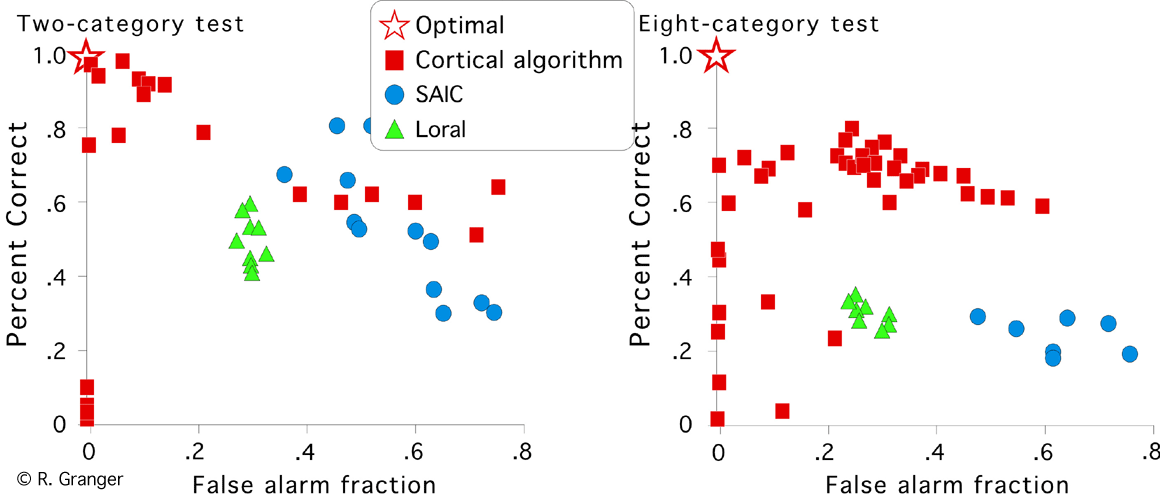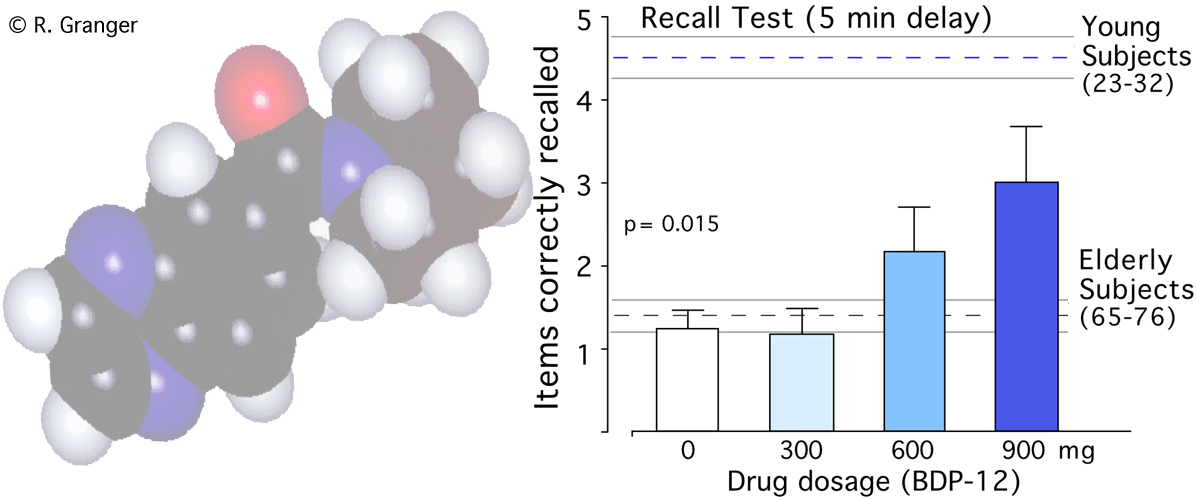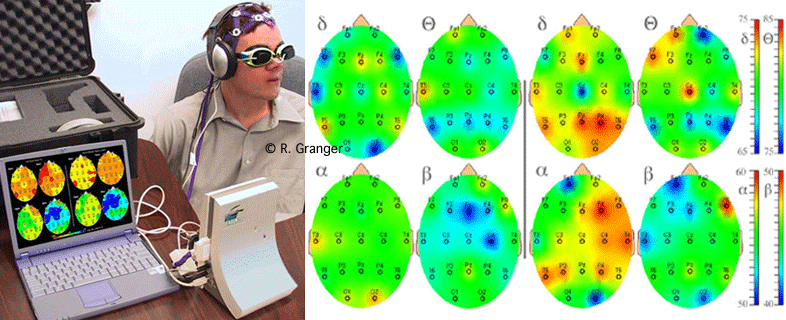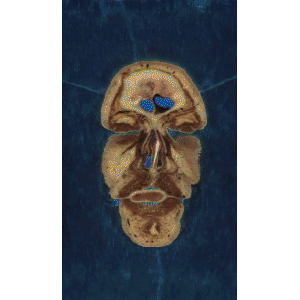|
|
|
|
Brain Engineering Laboratory: Applications
|
|
|
|
Applications.
The computational algorithms derived from brain circuit analysis research have, in some cases, led to methods that have found application in military, industrial, and medical domains. A few examples follow:
 Researchers at the U.S. Navy demonstrated that algorithms derived from paleocortex and hippocampus ("Cortical Algorithm" in the figure) outperformed competing methods on analysis and classification of complex signals. [Kowtha, V., Satyanarayana, P., Granger, R., and Stenger, D. (1994). Learning and classification in a noisy environment by a simulated cortical network. Proc. Third Ann. Comp. Neural Systems Conf., Boston: Kluwer, pp. 245-250].
Researchers at the U.S. Navy demonstrated that algorithms derived from paleocortex and hippocampus ("Cortical Algorithm" in the figure) outperformed competing methods on analysis and classification of complex signals. [Kowtha, V., Satyanarayana, P., Granger, R., and Stenger, D. (1994). Learning and classification in a noisy environment by a simulated cortical network. Proc. Third Ann. Comp. Neural Systems Conf., Boston: Kluwer, pp. 245-250].
 Novel designs for new kinds of hardware devices (chips) have been constructed, and new ones are under development. [Hammerstrom, D. (2000). Computational Neurobiology Meets
Semiconductor Engineering. 2000 Conference on Multivalued Logic, IEEE Press].
Novel designs for new kinds of hardware devices (chips) have been constructed, and new ones are under development. [Hammerstrom, D. (2000). Computational Neurobiology Meets
Semiconductor Engineering. 2000 Conference on Multivalued Logic, IEEE Press].
 Drugs for the treatment of glutamate-based diseases, including Alzheimer's, schizophrenia, ADHD, and autism, have been developed and shown effective in animal and human subjects. The drug shown above, known in the laboratory as BDP-12, has now been used in extensive FDA-approved clinical tests around the country. The graph shows significant improvement in the ability of elderly human subjects taking the drug, raising their recall level to that of healthy young subjects.
[Lynch, G., Granger, R., Davis, M., Ambros-Ingerson, J., Kessler, M., Schehr, R. (1997). Evidence that a positive modulator of glutamate receptors improves recall in elderly human subjects. Experimental Neurology, 145: 89-92].
Drugs for the treatment of glutamate-based diseases, including Alzheimer's, schizophrenia, ADHD, and autism, have been developed and shown effective in animal and human subjects. The drug shown above, known in the laboratory as BDP-12, has now been used in extensive FDA-approved clinical tests around the country. The graph shows significant improvement in the ability of elderly human subjects taking the drug, raising their recall level to that of healthy young subjects.
[Lynch, G., Granger, R., Davis, M., Ambros-Ingerson, J., Kessler, M., Schehr, R. (1997). Evidence that a positive modulator of glutamate receptors improves recall in elderly human subjects. Experimental Neurology, 145: 89-92].
 Novel methods based on thalamocortical algorithms have been used to analyze data from an EEG-based (electroencephalographic) device, the NeuroGraph, to aid doctors in the early diagnosis of brain diseases such as Alzheimer's, schizophrenia, clinical depression, and ADHD. These methods are undergoing continued testing in laboratories at major clinical sites in the U.S. and Europe. [Benvenuto, J., Jin, Y., Casale, M., Lynch, G., Granger, R. (2002). Identification of diagnostic evoked response potential segments in Alzheimer's Disease. Experimental Neurology, 176: 269-276].
Novel methods based on thalamocortical algorithms have been used to analyze data from an EEG-based (electroencephalographic) device, the NeuroGraph, to aid doctors in the early diagnosis of brain diseases such as Alzheimer's, schizophrenia, clinical depression, and ADHD. These methods are undergoing continued testing in laboratories at major clinical sites in the U.S. and Europe. [Benvenuto, J., Jin, Y., Casale, M., Lynch, G., Granger, R. (2002). Identification of diagnostic evoked response potential segments in Alzheimer's Disease. Experimental Neurology, 176: 269-276].
Interview on CNN Headline News discussing the NeuroGraph
Summary
Analysis of a number of important human brain circuits has led to specific and distinct hypotheses of their functions. Simulations at various levels of simplification and abstraction have demonstrated substantial computational power and efficiency of the hypothesized operations.
Extensive mathematical characterization of these functions, and comparison with related algorithms have been performed and published in scientific journals.
Many of the resulting derived algorithmic methods have led to applications in military, commercial, and medical domains.
Specific anatomical, physiological, and behavioral predictions have been tested in animal and human experiments, with results that support the growing body of hypotheses.
Further construction of computational simulation systems, more extensive mathematical analyses, and continued empirical testing of biological and behavioral predictions, are ongoing in our laboratory.
|

© 2005 TSG.RHG
[GrangerLab]
|
|

